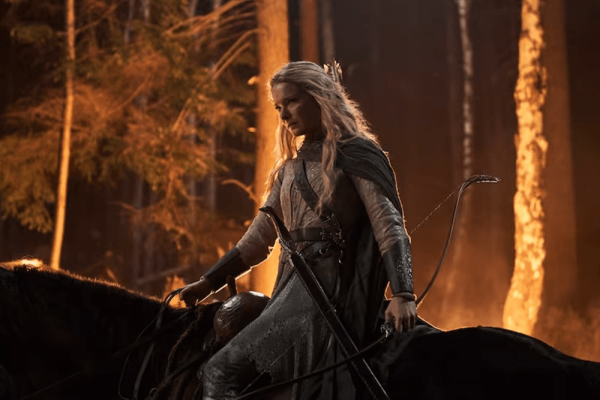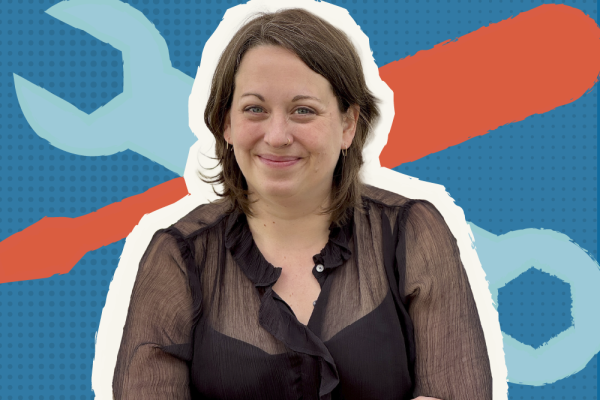The Lord of the Rings: The Rings of Power returned for its second season, bringing viewers back to a sprawling story inspired by the works of J.R.R. Tolkien. Showrunners J.D. Payne and Patrick McKay’s Prime Video streaming series is set in Tolkien’s Middle-earth during the Second Age, a period of turmoil prior to the events of The Hobbit and the Lord of the Rings trilogy. The events depicted in the show lead to the creation of the One Ring, the all-powerful magical item at the heart of Tolkien’s books, and the rise of Sauron, the evil sorcerer who created it.
If the first season of The Rings of Power was about recognizing evil in the world, the show’s second season is a deeper exploration of evil’s slippery nature, and the ways it can take hold in each of us, often through forms that don’t seem damaging at all…at least at first.
“The best villains have relatable intentions even if their means are abhorrent,” McKay says. “Beyond moral thematics, we hope every one of our characters is compelling and dimensional whether they do good or evil.”
Part of that moral complexity comes from Tolkien’s own motivations and interests as a writer, informed by his Catholic faith and experiences in the British Army during WWI, where he witnessed both physical and environmental devastation and the effects of industrial advances in military weaponry. McKay says the show takes those themes seriously.
“Tolkien was very distrustful of industrialization. A major theme in Lord of the Rings is technology imposing itself on nature and disrupting the natural order,” McKay says. “Even though the rings Sauron creates can be used for good, rings are Tolkien’s metaphor for the machine, something powerful that seeks to overcome the natural order.”
Every race in Tolkien’s Middle-earth, McKay says, faces an existential threat in The Rings of Power that they want to overcome, and the rings provide an answer — and consequences — for season two to explore. “Tolkien was suspicious about easy solutions,” McKay says. “This season is about, ‘What is the collateral damage of a shortcut to solve a big problem?’”
Spoilers for the first season of The Lord of the Rings: The Rings of Power follow.
In the first season of The Rings of Power, viewers were introduced to various crises facing the elves, the dwarves, men, and other creatures of Middle-earth following a great war during which it was presumed Sauron was destroyed. Elven warrior Galadriel (Morfydd Clark) remained unconvinced and refused the order to return to the elves’ homeland of Valinor. Instead, she teamed up with Halbrand (Charlie Vickers), a disgraced ruler of men, to convince the people of the island kingdom of Númenor to join the fight against Sauron.
Galadriel and Halbrand, along with key elven and dwarven allies, created rings that channeled great power to restore the elves’ waning existence. Anyone familiar with Tolkien’s books or the preamble to Peter Jackson’s Lord of the Rings films knows exactly where this is going. Halbrand proved especially helpful in the smithing process and harnessing the power of the dwarves’ mithril ore. This is because, in a dramatic reveal, he was actually Sauron in disguise. Sauron invited Galadriel to join him in his enterprise, but she cast him out, disgusted.
While Sauron has left Lindon behind, the rings he created are still with the elves, and the purpose they serve — though clearly corrupted — fulfills a great need. The question remains: Will they use them?
It’s a question co-showrunner Payne says becomes a major consideration for season two. “Various characters in season two and beyond are faced with that moral test,” Payne says. “If you were given a ring, and that could supercharge you, and help you achieve goals more quickly, would you take the ring?”
That same idea — seeking quick fixes when faced with the fear of destruction, mortality, or even systemic change — is a fundamental part of how the Bible identifies sin. It’s there from the very beginning, when the serpent tempts Eve in the garden with fruit from the tree of knowledge. Eve taking that fruit and sharing it with Adam alters the way they relate to God’s creation forever. Their choice echoes through the rest of the Bible, whether it’s the Israelites worshiping a golden calf in Exodus, Israel’s demand for a king in 1 Samuel, or the Pharisees’ fear of Jesus’ revolutionary teachings in the gospels.
As Christians today consider how we live in the world — from making ethical choices about money to the politicians we support to how we engage with modern technology — those patterns persist. We want to ease our suffering, and when we attempt to solve it with worldly solutions rather than trust in God’s guidance, moral compromises inevitably follow. Some of them, like those that arose from the industrialization Tolkien so distrusted, have consequences that create crises of their own.
As another example, Payne says, consider Adar (played in season two by Sam Hazeldine), the leader of the Orcs, whose actions in the Southlands last season created the industrialized, blackened land Lord of the Rings fans know as Mordor.
“Adar’s name means ‘father,’ and all he wants to do is take care of his kids,” Payne says. “To do that he has to blow up a volcano and turn his people into refugees. He’s another character who does the wrong thing for the right reason.”
Heroes, villains, and flaws
The first season set up the problems facing the peoples of Middle-earth, some of which caused clashes and distrust between different races. The second digs deeper into the newly-created solution to many of those problems — Sauron’s rings — and the hidden compromise within them: his growing influence.
“Some villains can see your weaknesses and exploit them,” Payne says. “Sauron is scary because he sees your strengths and can manipulate that to his will.”
But, just like the rest of the show’s characters, Payne says, Sauron isn’t a monolith. Part of what makes him compelling is that his motives, though enacted through evil, are similar to those of the show’s heroes. “Sauron wants to rehabilitate Middle-earth, but he does it in ways that violate the agency of the people around him,” Payne says. “If everyone just did exactly what Sauron wanted, to him that would be great.”
The opposite is true as well, McKay adds, in that the show’s heroes face legitimate needs that they make moral compromises to fulfill. “Galadriel is a character I adore in the books, but she’s also kind of a mess. She’s very flawed,” McKay says. “Our good guys have aspects that could be better, our bad guys have characteristics that could be good.”
These characters’ desires, fears, needs, and the ways they address them (or are manipulated into addressing them in damaging ways) are reflective of Tolkien’s faith, and the themes in his writing that have captured readers of diverse backgrounds for generations.
It’s also, McKay says, the foundation of compelling writing. “Characters who are unabashedly heroic but deeply flawed is one of the joys of writing the show.”
Making the themes cohere
While there’s a lot going on in the show’s first and second seasons, McKay insists season two offers a jumping on point for new viewers. “We think season two is a great jumping on point for people who didn’t tune in the first time around,” McKay says. “We want to bring in people who are maybe not even Lord of the Rings fans and expand out to a larger audience.”
To that end, Payne notes the second season’s many explorations of genre. “For any Tolkien fan, there’s a balance of stories you want. One moment you’ve got political intrigue, another you’re in a horror movie with scary monsters in the woods, the next you’re hanging out with halflings who are singing and laughing. It’s those gear-shifts that make it feel like Middle-earth. For us, we’re constantly asking, ‘Do we have enough of each ingredient?’”
Payne says the show’s team has reached that desired balance. “We know everything is headed toward the last alliance, and we see glimmers of that as different characters start to pair up to combat Sauron’s plans,” he says.
McKay assures that a big part of that is figuring out how to move between the show’s many threads so that they match thematically and help move the story further along. “Cutting between those stories is a thing we obsess about all the time. What can you cut from that leaves you salivating, and what can you cut to? It’s what we spend so much of our time thinking about,” McKay says. “This is the craft of the show that separates the men from the boys in a way.”
Of course, the roadmap matters, too, and Payne says season two has an impressive destination that combines all of the themes they’ve been exploring into an epic climax. “The whole thing heads toward a big battle that takes three episodes to play out, with people, even some who might have been enemies before, coming together to defeat Sauron. The scope is bigger than anything we attempted in season one.”
Got something to say about what you're reading? We value your feedback!







